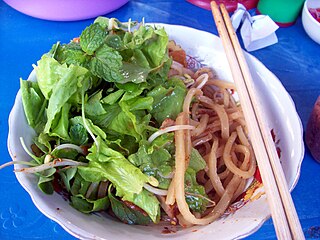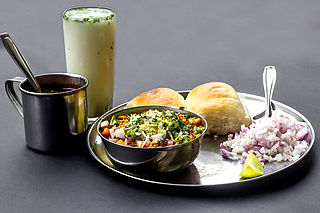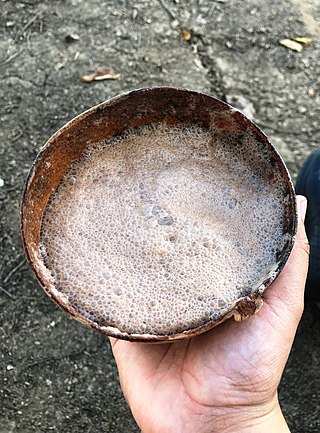
Chop suey is a dish from American Chinese cuisine and other forms of overseas Chinese cuisine, generally consisting of meat and eggs, cooked quickly with vegetables such as bean sprouts, cabbage, and celery, and bound in a starch-thickened sauce. It is typically served with rice, but can become the Chinese-American form of chow mein with the substitution of stir-fried noodles for rice.

Sprouting is the natural process by which seeds or spores germinate and put out shoots, and already established plants produce new leaves or buds, or other structures experience further growth.

The mung bean or green gram is a plant species in the legume family. The mung bean is mainly cultivated in East, Southeast and South Asia. It is used as an ingredient in both savoury and sweet dishes.

Penang cuisine is the cuisine of the multicultural society of Penang, Malaysia. Most of these cuisine are sold at road-side stalls, known as "hawker food" and colloquially as "muckan carts". Local Penangites typically find these hawker fares cheaper and easier to eat out at due to the ubiquitousness of the hawker stalls and that they are open for much of the day and night. Penang island. On February 22, 2013, Penang was ranked by CNN Travel as one of the top ten street food cities in Asia. Penang has also been voted by Lonely Planet as the top culinary destination in 2014.

Cao lầu is a regional Vietnamese noodle dish, from the city of Hội An, in central Vietnam's Quảng Nam Province. It typically consists of pork and greens on a bed of rice noodles made from rice which has been soaked in lye water, giving them a characteristic texture and colour that sets the dish apart from other Vietnamese noodle dishes, including others from the same region, such as mì Quảng.

Soybean sprout is a culinary vegetable grown by sprouting soybeans. It can be grown by placing and watering the sprouted soybeans in the shade until the roots grow long. Soybean sprouts are extensively cultivated and consumed in Asian countries.
A sattvic diet is a type of plant-based diet within Ayurveda where food is divided into what is defined as three yogic qualities (guna) known as sattva. In this system of dietary classification, foods that decrease the energy of the body are considered tamasic, while those that increase the energy of the body are considered rajasic. A sattvic diet is sometimes referred to as a yogic diet in modern literature.

Rājmā, also known as rajmah, rāzmā, or lal lobia, is a vegetarian dish, originating from the Indian subcontinent, consisting of red kidney beans in a thick gravy with many Indian whole spices, and is usually served with rice. It is a part of the regular diet in Northern India, Nepal and Punjab province of Pakistan. The dish developed after the red kidney bean was brought to the Indian subcontinent from Mexico. Rajma Chawal is kidney beans served with boiled rice.

Mung bean sprouts are a culinary vegetable grown by sprouting mung beans. They can be grown by placing and watering the sprouted beans in the shade until the hypocotyls grow long. Mung bean sprouts are extensively cultivated and consumed in East and Southeast Asia and are very easy to grow, requiring minimal care other than a steady supply of water. They are often used in school science projects.

Misal is a very popular spicy dish in the Western Indian state of Maharashtra. The dish is mostly eaten for breakfast or as a midday snack or sometimes as a one-dish meal, often as part of misal pav. It remains a favourite snack since it is easy to make with affordable ingredients and has a good nutritional value. The taste of misal ranges from mildly to extremely spicy. And there are a lot of varieties as well. Misal is also a popular traditional food of Maharashtra. The dish is always served hot.

Misal pav is a dish from the Indian state of Maharashtra. It consists of misal and pav. The final dish is topped with farsan or sev, onions, lemon and coriander (cilantro). It is usually served hot with bread or rolls toasted with butter and buttermilk or dahi and papad. It is served as a breakfast dish, as a snack and also as a full meal.

Mee goreng, or mi goreng, refers to fried noodles in the Malay-speaking cultures of several countries, such as the Southeast Asian states of Brunei, Malaysia, and Singapore.

Asinan is a pickled vegetable or fruit dish, commonly found in Indonesia. Asin, Indonesian for "salty", is the process of preserving the ingredients by soaking them in a solution of salty water. Asinan is quite similar to rujak, which is usually served fresh, while asinan is preserved vegetables or fruits. Of the many types and variations of asinan in Indonesia, the most popular are asinan Betawi and asinan Bogor. Asinan can be found in restaurants, warung, and travelling street vendor.

Urap is a salad dish of steamed vegetables mixed with seasoned and spiced grated coconut for dressing. It is commonly found in Indonesian cuisine, more precisely Javanese cuisine. Urap can be consumed on its own as a salad for vegetarian meals or as a side dish. Urap is usually found as a prerequisite side dish of Javanese tumpeng, a cone-shaped rice mound surrounded with assorted dishes, as well as part of a nasi kuning dish. In Balinese cuisine, it is known as Urab sayur.

Tàⁿ-á-mī, also known as Ta-a noodles or danzai noodles, is a type of snack found in Tainan, Taiwan. Also known as "Slack Season Ta-a Noodles", they originated in Tainan about 130 years ago. While the general recipe is well known, some of the spices and the proportions of the various ingredients are well guarded secrets by the different restaurants/stands that serve it. The normal serving size is usually small, being considered more of a snack than an entree. It is also on the pricier side (relatively) at around NT$50 (US$1.60) for a small bowl.

Kwātī is a mixed soup of nine types of sprouted beans. It is a traditional Newari dish consumed on the festival of Guni Punhi, the full moon day of Gunlā which is the tenth month in the Nepal Era lunar calendar. It is also known and widely consumed as Gedagudi in the Mithila Region of Nepal, historically aligned down to Kingdom of Nepali people.

Soto is a traditional Indonesian soup mainly composed of broth, meat, and vegetables. Many traditional soups are called soto, whereas foreign and Western influenced soups are called sop.

Tauge goreng is an Indonesian savoury vegetarian dish made of stir-fried tauge with slices of tofu, ketupat or lontong rice cake and yellow noodles, served in a spicy oncom-based sauce. Tauge goreng is a specialty of Jakarta and Bogor city, West Java, Indonesia. It is usually sold as street food using pikulan or gerobak (cart) by street vendors. It is a popular street food in Indonesia, especially in Jakarta, and Greater Jakarta areas, including Bogor, Depok, Tangerang and Bekasi.

Indonesian noodles are a significant aspect of Indonesian cuisine which is itself very diverse. Indonesian cuisine recognizes many types of noodles, with each region of the country often developing its own distinct recipes.

Popo is a foamy and cold drink typical in the south of the state of Veracruz and some areas of the state of Oaxaca, like the basin of Papaloapan or Istmo. Its main ingredient is cocoa, which is sweetened with sugar or panela, and is mixed with water; also azquiote called cocomeca en Oaxaca is added, and/or chupipi, both foaming agents. Some recipes frequently flavor it with cinnamon and/or anise, and they thicken it with maize dough or rice.



















